Page 268 of 434
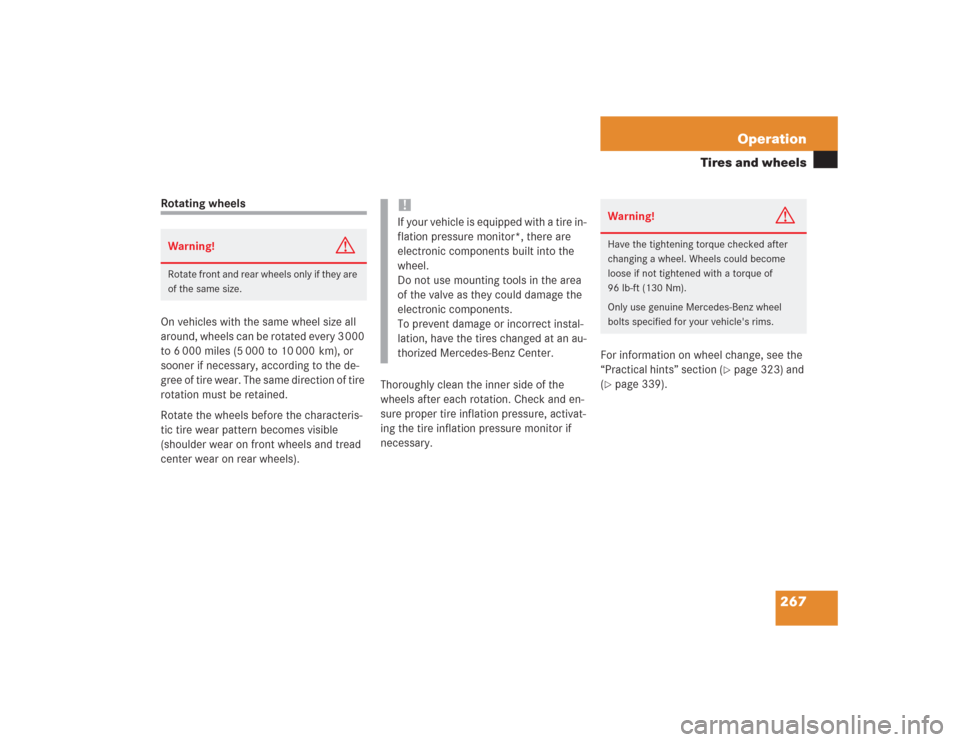
267 Operation
Tires and wheels
Rotating wheels
On vehicles with the same wheel size all
around, wheels can be rotated every 3 000
to 6 000 miles (5 000 to 10 000 km), or
sooner if necessary, according to the de-
gree of tire wear. The same direction of tire
rotation must be retained.
Rotate the wheels before the characteris-
tic tire wear pattern becomes visible
(shoulder wear on front wheels and tread
center wear on rear wheels).Thoroughly clean the inner side of the
wheels after each rotation. Check and en-
sure proper tire inflation pressure, activat-
ing the tire inflation pressure monitor if
necessary. For information on wheel change, see the
“Practical hints” section (
�page 323) and
(
�page 339).
Warning!
G
Rotate front and rear wheels only if they are
of the same size.
!If your vehicle is equipped with a tire in-
flation pressure monitor*, there are
electronic components built into the
wheel.
Do not use mounting tools in the area
of the valve as they could damage the
electronic components.
To prevent damage or incorrect instal-
lation, have the tires changed at an au-
thorized Mercedes-Benz Center.
Warning!
G
Have the tightening torque checked after
changing a wheel. Wheels could become
loose if not tightened with a torque of
96 lb-ft (130 Nm).
Only use genuine Mercedes-Benz wheel
bolts specified for your vehicle's rims.
Page 269 of 434
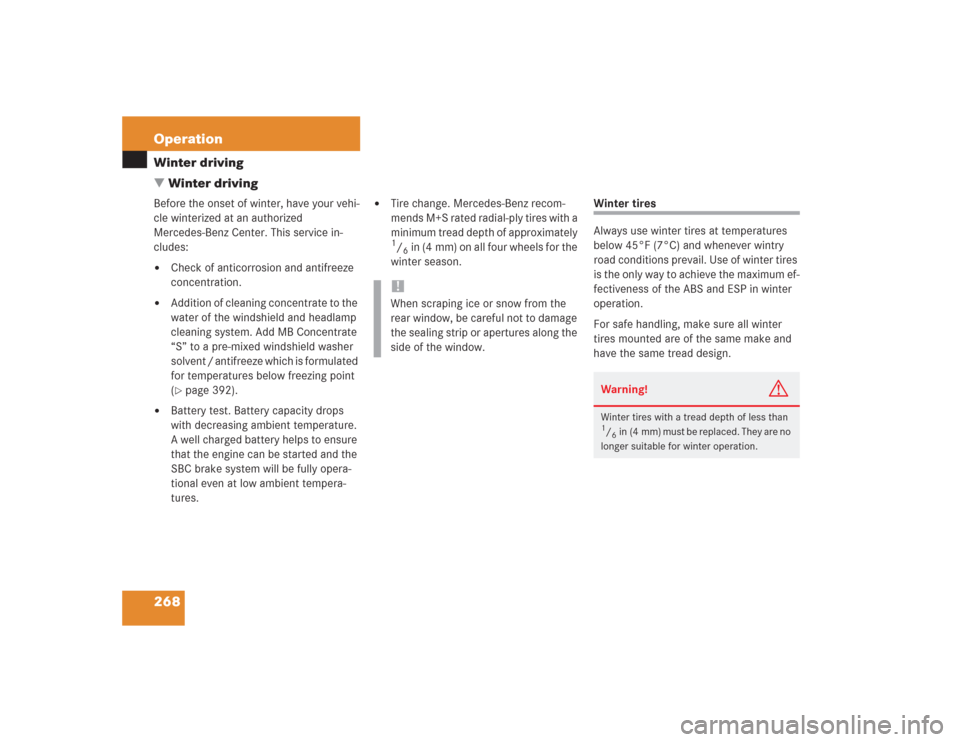
268 OperationWinter driving
�Winter drivingBefore the onset of winter, have your vehi-
cle winterized at an authorized
Mercedes-Benz Center. This service in-
cludes:�
Check of anticorrosion and antifreeze
concentration.
�
Addition of cleaning concentrate to the
water of the windshield and headlamp
cleaning system. Add MB Concentrate
“S” to a pre-mixed windshield washer
solvent / antifreeze which is formulated
for temperatures below freezing point
(�page 392).
�
Battery test. Battery capacity drops
with decreasing ambient temperature.
A well charged battery helps to ensure
that the engine can be started and the
SBC brake system will be fully opera-
tional even at low ambient tempera-
tures.
�
Tire change. Mercedes-Benz recom-
mends M+S rated radial-ply tires with a
minimum tread depth of approximately 1/6in (4 mm) on all four wheels for the
winter season.
Winter tires
Always use winter tires at temperatures
below 45°F (7°C) and whenever wintry
road conditions prevail. Use of winter tires
is the only way to achieve the maximum ef-
fectiveness of the ABS and ESP in winter
operation.
For safe handling, make sure all winter
tires mounted are of the same make and
have the same tread design.
!When scraping ice or snow from the
rear window, be careful not to damage
the sealing strip or apertures along the
side of the window.
Warning!
G
Winter tires with a tread depth of less than 1/6in (4 mm) must be replaced. They are no
longer suitable for winter operation.
Page 270 of 434
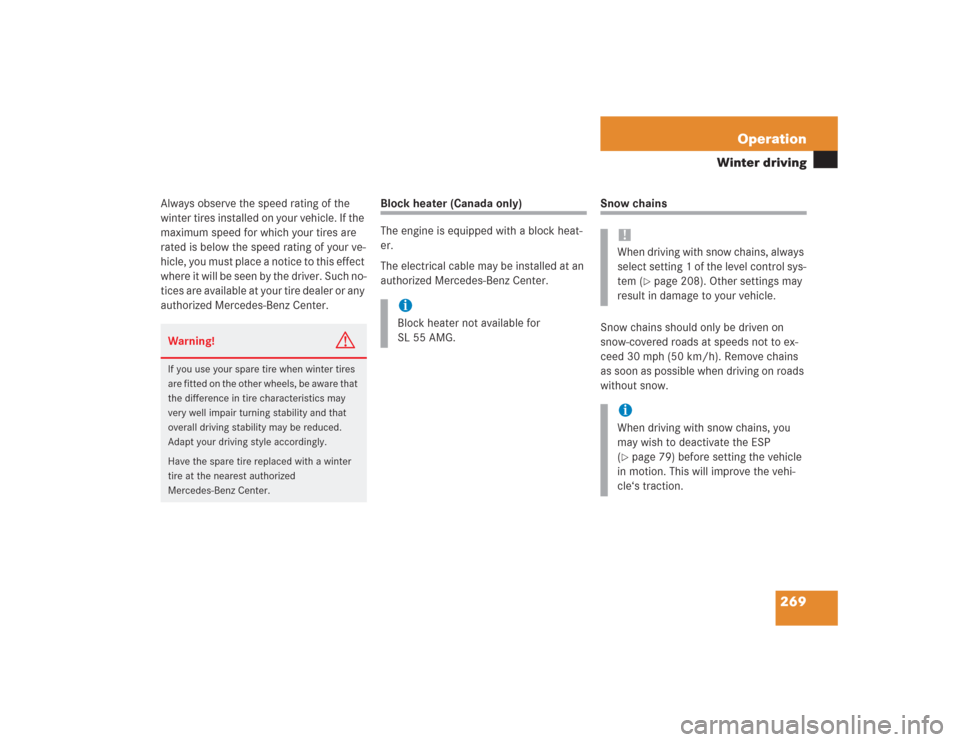
269 Operation
Winter driving
Always observe the speed rating of the
winter tires installed on your vehicle. If the
maximum speed for which your tires are
rated is below the speed rating of your ve-
hicle, you must place a notice to this effect
where it will be seen by the driver. Such no-
tices are available at your tire dealer or any
authorized Mercedes-Benz Center.
Block heater (Canada only)
The engine is equipped with a block heat-
er.
The electrical cable may be installed at an
authorized Mercedes-Benz Center.
Snow chains
Snow chains should only be driven on
snow-covered roads at speeds not to ex-
ceed 30 mph (50 km/h). Remove chains
as soon as possible when driving on roads
without snow.
Warning!
G
If you use your spare tire when winter tires
are fitted on the other wheels, be aware that
the difference in tire characteristics may
very well impair turning stability and that
overall driving stability may be reduced.
Adapt your driving style accordingly.
Have the spare tire replaced with a winter
tire at the nearest authorized
Mercedes-Benz Center.
iBlock heater not available for
SL 55 AMG.
!When driving with snow chains, always
select setting 1 of the level control sys-
tem (
�page 208). Other settings may
result in damage to your vehicle.
iWhen driving with snow chains, you
may wish to deactivate the ESP
(�page 79) before setting the vehicle
in motion. This will improve the vehi-
cle‘s traction.
Page 273 of 434
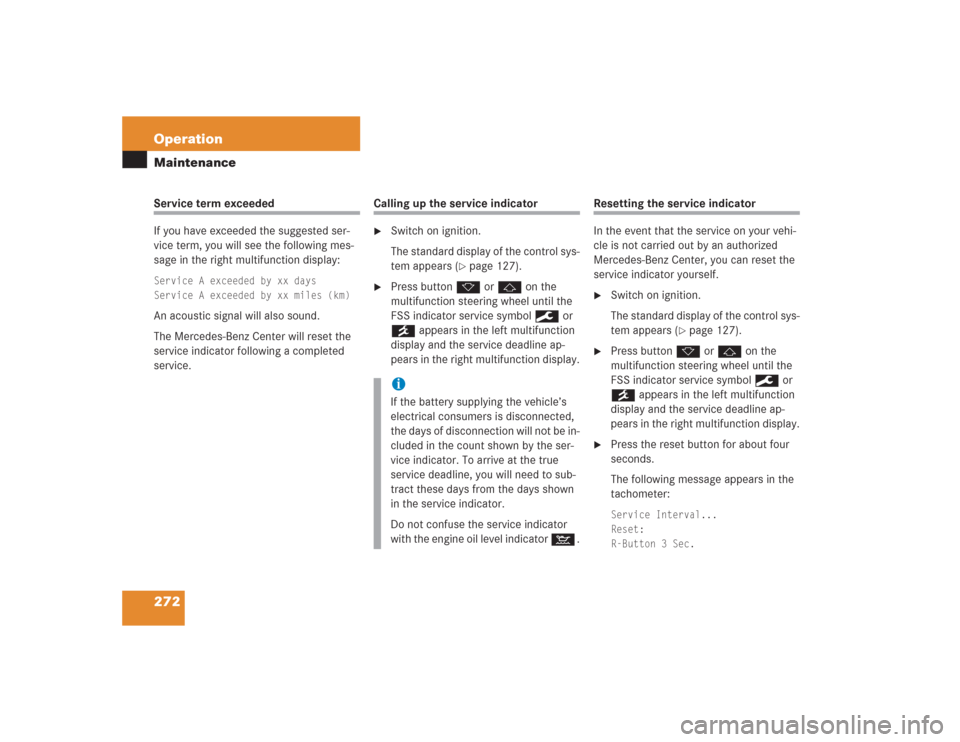
272 OperationMaintenanceService term exceeded
If you have exceeded the suggested ser-
vice term, you will see the following mes-
sage in the right multifunction display:Service A exceeded by xx days
Service A exceeded by xx miles (km)An acoustic signal will also sound.
The Mercedes-Benz Center will reset the
service indicator following a completed
service.
Calling up the service indicator�
Switch on ignition.
The standard display of the control sys-
tem appears (
�page 127).
�
Press button k or j on the
multifunction steering wheel until the
FSS indicator service symbol 9 or
´ appears in the left multifunction
display and the service deadline ap-
pears in the right multifunction display.
Resetting the service indicator
In the event that the service on your vehi-
cle is not carried out by an authorized
Mercedes-Benz Center, you can reset the
service indicator yourself.�
Switch on ignition.
The standard display of the control sys-
tem appears (
�page 127).
�
Press button k or j on the
multifunction steering wheel until the
FSS indicator service symbol 9 or
´ appears in the left multifunction
display and the service deadline ap-
pears in the right multifunction display.
�
Press the reset button for about four
seconds.
The following message appears in the
tachometer:Service Interval...
Reset:
R-Button 3 Sec.
iIf the battery supplying the vehicle’s
electrical consumers is disconnected,
the days of disconnection will not be in-
cluded in the count shown by the ser-
vice indicator. To arrive at the true
service deadline, you will need to sub-
tract these days from the days shown
in the service indicator.
Do not confuse the service indicator
with the engine oil level indicator :.
Page 278 of 434
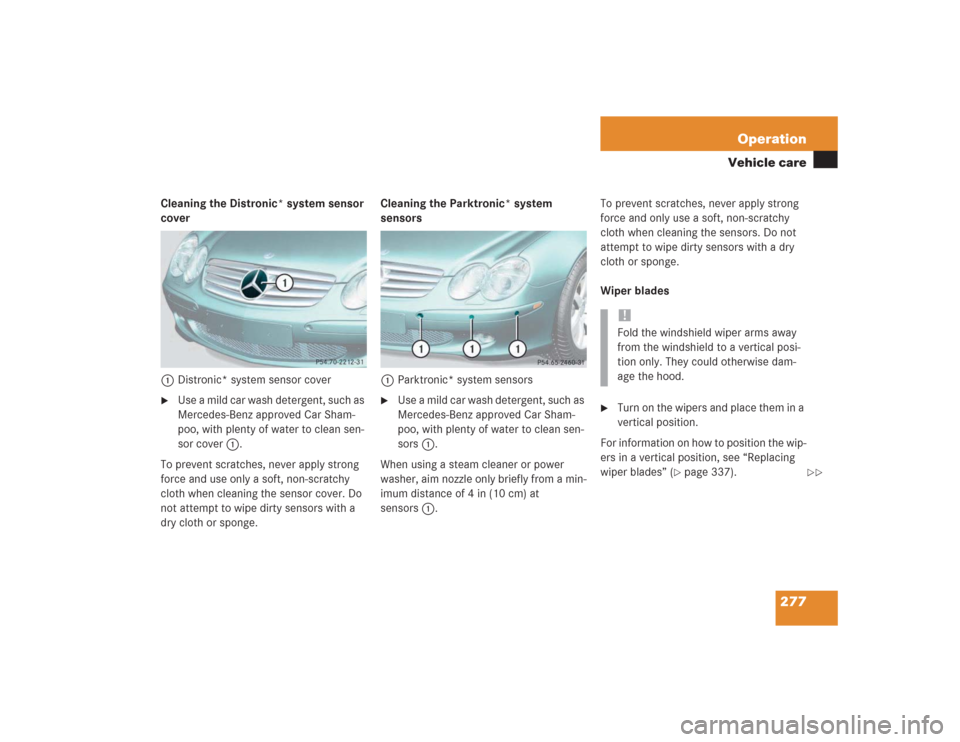
277 Operation
Vehicle care
Cleaning the Distronic* system sensor
cover
1Distronic* system sensor cover�
Use a mild car wash detergent, such as
Mercedes-Benz approved Car Sham-
poo, with plenty of water to clean sen-
sor cover1.
To prevent scratches, never apply strong
force and use only a soft, non-scratchy
cloth when cleaning the sensor cover. Do
not attempt to wipe dirty sensors with a
dry cloth or sponge.Cleaning the Parktronic* system
sensors
1Parktronic* system sensors
�
Use a mild car wash detergent, such as
Mercedes-Benz approved Car Sham-
poo, with plenty of water to clean sen-
sors 1.
When using a steam cleaner or power
washer, aim nozzle only briefly from a min-
imum distance of 4 in (10 cm) at
sensors1.To prevent scratches, never apply strong
force and only use a soft, non-scratchy
cloth when cleaning the sensors. Do not
attempt to wipe dirty sensors with a dry
cloth or sponge.
Wiper blades
�
Turn on the wipers and place them in a
vertical position.
For information on how to position the wip-
ers in a vertical position, see “Replacing
wiper blades” (
�page 337).
!Fold the windshield wiper arms away
from the windshield to a vertical posi-
tion only. They could otherwise dam-
age the hood.
��
Page 279 of 434
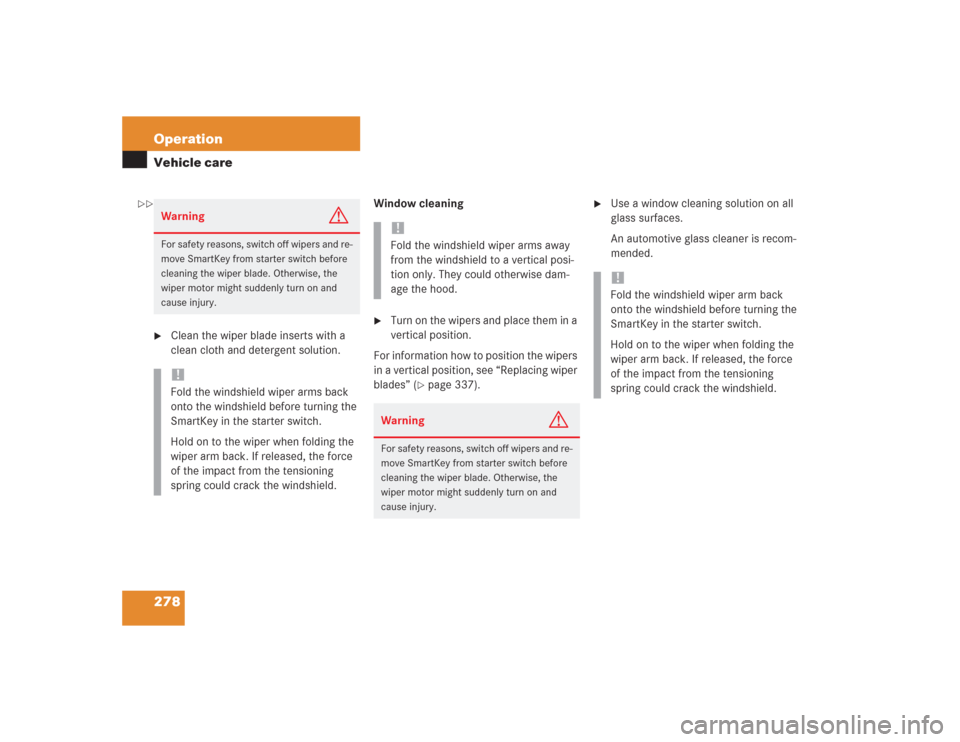
278 OperationVehicle care�
Clean the wiper blade inserts with a
clean cloth and detergent solution.Window cleaning
�
Turn on the wipers and place them in a
vertical position.
For information how to position the wipers
in a vertical position, see “Replacing wiper
blades” (
�page 337).
�
Use a window cleaning solution on all
glass surfaces.
An automotive glass cleaner is recom-
mended.
Warning
G
For safety reasons, switch off wipers and re-
move SmartKey from starter switch before
cleaning the wiper blade. Otherwise, the
wiper motor might suddenly turn on and
cause injury.!Fold the windshield wiper arms back
onto the windshield before turning the
SmartKey in the starter switch.
Hold on to the wiper when folding the
wiper arm back. If released, the force
of the impact from the tensioning
spring could crack the windshield.
!Fold the windshield wiper arms away
from the windshield to a vertical posi-
tion only. They could otherwise dam-
age the hood.Warning
G
For safety reasons, switch off wipers and re-
move SmartKey from starter switch before
cleaning the wiper blade. Otherwise, the
wiper motor might suddenly turn on and
cause injury.
!Fold the windshield wiper arm back
onto the windshield before turning the
SmartKey in the starter switch.
Hold on to the wiper when folding the
wiper arm back. If released, the force
of the impact from the tensioning
spring could crack the windshield.
��
Page 283 of 434
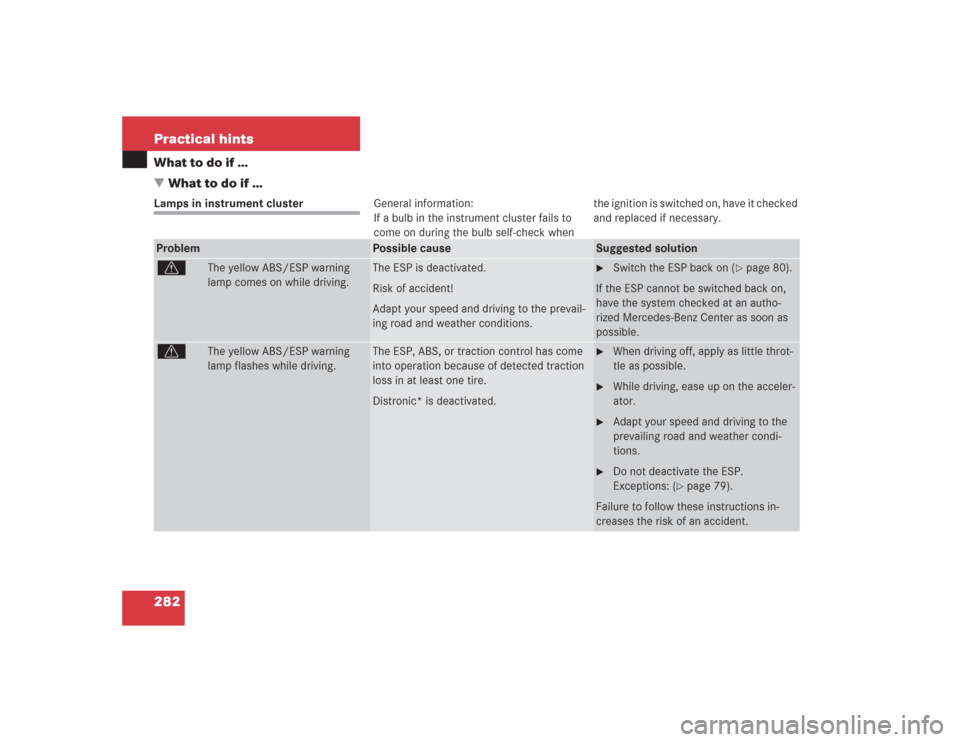
282 Practical hintsWhat to do if …
�What to do if …Lamps in instrument clusterGeneral information:
If a bulb in the instrument cluster fails to
come on during the bulb self-check when the ignition is switched on, have it checked
and replaced if necessary.Problem
Possible cause
Suggested solution
v
The yellow ABS/ESP warning
lamp comes on while driving.
The ESP is deactivated.
Risk of accident!
Adapt your speed and driving to the prevail-
ing road and weather conditions.
�
Switch the ESP back on (
�page 80).
If the ESP cannot be switched back on,
have the system checked at an autho-
rized Mercedes-Benz Center as soon as
possible.
v
The yellow ABS/ESP warning
lamp flashes while driving.
The ESP, ABS, or traction control has come
into operation because of detected traction
loss in at least one tire.
Distronic* is deactivated.
�
When driving off, apply as little throt-
tle as possible.
�
While driving, ease up on the acceler-
ator.
�
Adapt your speed and driving to the
prevailing road and weather condi-
tions.
�
Do not deactivate the ESP.
Exceptions: (
�page 79).
Failure to follow these instructions in-
creases the risk of an accident.
Page 284 of 434
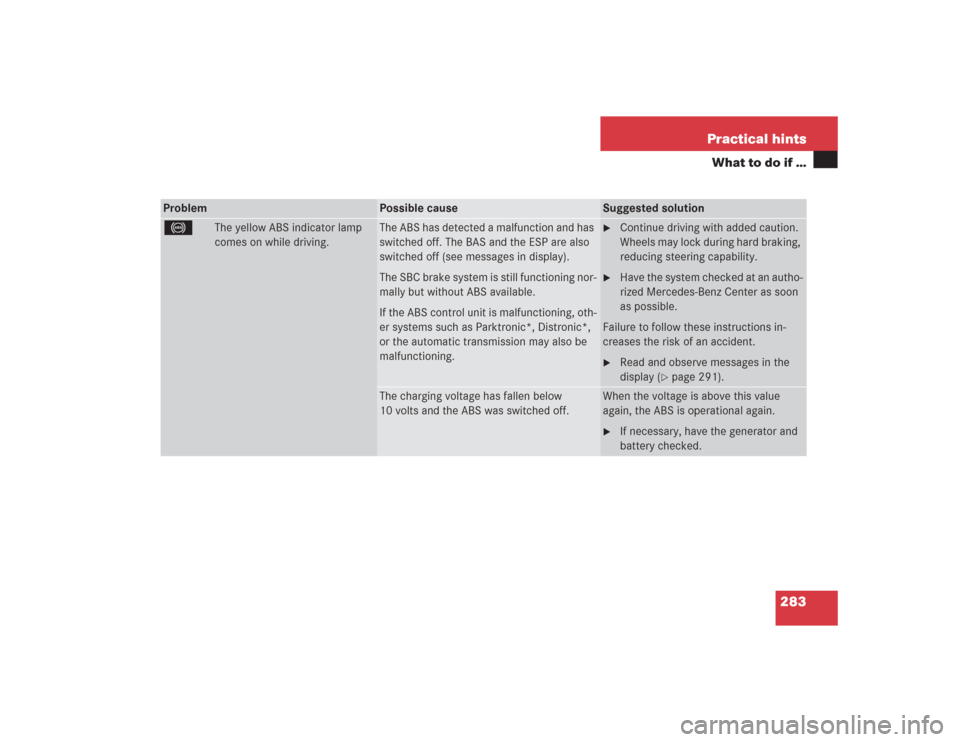
283 Practical hints
What to do if …
Problem
Possible cause
Suggested solution
-
The yellow ABS indicator lamp
comes on while driving.
The ABS has detected a malfunction and has
switched off. The BAS and the ESP are also
switched off (see messages in display).
The SBC brake system is still functioning nor-
mally but without ABS available.
If the ABS control unit is malfunctioning, oth-
er systems such as Parktronic*, Distronic*,
or the automatic transmission may also be
malfunctioning.
�
Continue driving with added caution.
Wheels may lock during hard braking,
reducing steering capability.
�
Have the system checked at an autho-
rized Mercedes-Benz Center as soon
as possible.
Failure to follow these instructions in-
creases the risk of an accident.
�
Read and observe messages in the
display (
�page 291).
The charging voltage has fallen below
10 volts and the ABS was switched off.
When the voltage is above this value
again, the ABS is operational again.�
If necessary, have the generator and
battery checked.